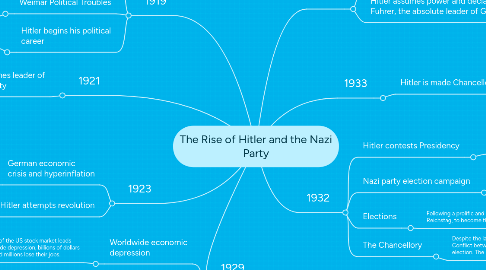
1. 1923
1.1. German economic crisis and hyperinflation
1.1.1. Following WWI and the signing of the Treaty of Versailles, Germany faces an economic crisis which leads to hyperinflation.
1.2. Hitler attempts revolution
1.2.1. After attempting a revolution and failing to gain power, Hitler is imprisoned for 9 months. This makes him a highly publicised figure and is perhaps a ploy to achieve publicity.
2. 1919
2.1. Treaty of Versailles
2.1.1. Germany is forced to sign the humiliating Treaty of Versailles and commit to territorial losses, military reduction, acceptance of the War Guilt Clause and reparation payments.
2.2. Weimar Political Troubles
2.2.1. The Weimar Republic tries to withstand the threat of revolution from extremist political wings throughout 1919 and 1920.
2.3. Hitler begins his political career
2.3.1. At the age of 30, Hitler joins the National Socialist German Worker's Party (Nazi Party).
3. 1921
3.1. Hitler becomes leader of the Nazi party
3.1.1. Hitler's exceptional oratory skills lead to his rise to prominence in the Nazi party.
4. 1929
4.1. Worldwide economic depression
4.1.1. The crash of the US stock market leads to worldwide depression, billions of dollars are lost and millions lose their jobs.
4.2. Growth of Nazi Party
4.2.1. The Nazi party and other political extremists use the economic depression to undermine confidence in the Weimar government. Their numbers increase dramatically.
5. 1932
5.1. Hitler contests Presidency
5.1.1. He is unsuccessful and Hindenburg remains the President.
5.2. Nazi party election campaign
5.2.1. The Nazi party runs an extremely successful campaign. This gives Hitler a visible presence. Party emblems, flags and other insignia are used at rallies to make people feel included in a national movement. Mass media is used to spread their ideology.
5.3. Elections
5.3.1. Following a prolific and successful campaign, the Nazi party wins 230 seats in the Reichstag, to become the strongest party.
5.4. The Chancellory
5.4.1. Despite the large Nazi vote, Hindenburg refuses to make Hitler Chancellor. Conflict between the Nazis and Chancellor von Papen leads to a new election. The Nazis lose 34 seats.
6. 1934
6.1. President Hindenburg dies in August 1934.
6.2. Hitler assumes power and declares himself Fuhrer, the absolute leader of Germany.
7. 1933
7.1. Hitler is made Chancellor
7.1.1. Through the political scheming of political conservative elites, an aged and vulnerable Hindenburg is convinced to make Hitler Chancellor.
